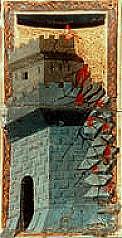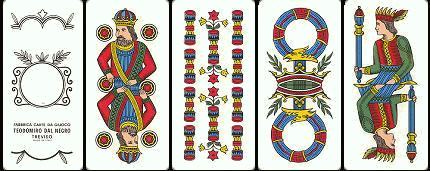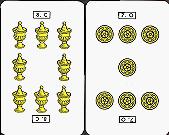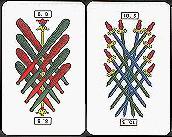The very first tarot decks were painted or engraved by artists, and
only the élite who could afford such luxury crafts played card games. When a new pack
was produced, the subjects were likely borrowed from works such as paintings,
illuminated books, cards, etc., which the author knew for having seen them
locally or in other princely courts previously visited.
This is how different decks became graphically related to geographic regions or
cities; the further was the distance between two areas, the greater might have
been the differences between the playing cards locally manufactured. Furthermore,
not only the graphic style varied, but also the rank or value of the trumps, thus their ordering,
was subject to certain changes.
Tarot historian Michael Dummett has suggested that three main patterns should be
considered as archetypes of the many varieties known, labelling them A, B and C.
Another tarot expert and collector, Tom Tadfor Little, renamed the three groups
according to the geographic areas where they developed:
Woodblock printing and stencil colouring techniques helped to keep the
cost of tarot decks affordable: this enabled the game to spread across Europe in less than
one century, not only in noble courts but also among the common people.
In several countries the tarot's illustrations underwent further changes, according to
factors such as popular taste and local tradition. More consistent changes took place
in tarots whose suits turned to the French standard (Diamonds, Spades, etc.), although this
did not happen until the 19th century: the trumps, yet maintaining their
numbering from 1 to 21, lost their traditional subjects, replaced by genre scenes.
ITALY
TAROCCO BOLOGNESE all the cards shown are by Dal Negro (Italy)
|
the Fool and the Trivial Performer |
|
The Tarocco Bolognese, from the city of Bologna, has 62 cards.
It is called Tarocchino ("small tarot") as the Milanese pattern discussed in part 2, not
for its dimensions, despite the slim size, but for the fewer number of cards.
Each suit has an ace, values from 6 to 10, and the four usual courts.
The rank and subjects of the 22 trumps are slightly different from those of the
tarot of Marseille (see page III
for the comparative table). Bologna's tarot also rejected the use of having the
names of the subjects spelled on the relevant trump. |
Instead, western numerals appeared in some of the cards,
probably around the late 18th century, whereas in the Lombard pattern the trumps had
long since been numbered with roman numerals.
The choice of using only numbers from 5 (Love) to 16
(the Star) is explained by the particular structure of the set of trumps in game
played with this deck, by which only some of the subjects are "counted".
Furthermore, the apparent discrepancy in giving no.5 to Love, despite this
is the sixth card, is also explained by the same hierarchic scheme in the
Tarocchino game: the card usually considered the first trump,
the Trivial Performer, in play groups with other subjects at the bottom of the series (see table below). |
|
Fortitude and the Devil |
Due to this shift, though, the numerals featured on the trumps apparently indicate a lower
rank than the one these subjects really have.
The 22 trumps of Bologna's tarot are traditionally referred to by the players with names in dialect.
CARD No.
ll
l
5
6
7
8
9
10
11
12
13
14
15
16
ll
ll
ll
ll
ll
|
DIALECT NAMES
Béghet
Murett
l'Amàur
al Car
la Virtò
la Giustézzia
la Forza
la Furtòuna
al Rumetta
al Traditàur
la Mort
al Dièvel
la Tarr
el Strel
Lòuna
Sàul
Mand
Anzel
Mat
|
ACTUAL MEANING
the Trivial Performer
Small Moors (4 cards) [1]
Love
the Chariot
Virtue [2]
Justice
Fortitude/Strength
Fortune
the Hermit [3]
the Traitor
Death
the Devil
the Tower [4]
the Star
Moon
Sun
World
Angel
Fool
|
EQUIVALENT IN MARSEILLE'S TAROT
(according to Bologna's ordering)
the Trivial Performer
the Popess - the Empress - the Emperor - the Pope
the Lovers
the Chariot
Temperance
Justice
Fortitude/Strength
the Wheel of Fortune
the Hermit
the Hanged Man
Death
the Devil
the Tower
the Stars
the Moon
the Sun
the World
Judgement
the Fool
|
- l - these cards are known as
i Cuntadur ("the Counters");
- l - these ones are known as
el Ràssi ("the Red Cards");
- l - this series is known as i Taruc
("the Tarots");
- l - this series is known as
la Grànda ("the Great");
- l - the four Moors keep their name;
- 5 ~ 16 - the series of trumps with numerals is called
Nòmer ed Scavàzz (more or less "Breakneck Numbers", since an incomplete
series of these cards is referred to as scavezzo = "breakneck", or "topping"),
but each of them is also individually referred to with the relevant number.
- [1] - The earlier name of these subjects was "the Popes"
- [2] - Subject also referred to as "Temperance"
- [3] - The earlier name of this subject was "the Old Man"
- [4] - The earlier name of this subject was "Lightning"
Instead the 40 suit cards are referred to as pali, a word
that shares the same root of the Spanish word palos, i.e. "suits".
A distinctive feature of this pattern is the group of four male
characters of equal rank, into which the classic trumps Popess, Empress, Emperor
and Pope were turned in early times.
Initially known as the Popes, they were
renamed the Moors (also referred to as the Moorish Kings, or
Small Moors), following the ban issued in 1725 by pope Benedict XIII
upon the use of "the Pope" and "the Angel" as names for playing card subjects; the
latter, though, was never changed nor dropped.
|
|
the modern Moors (the central one is repeated)
and (far right) a Moor from a 1850 edition |
In 18th and 19th century editions they were four different personages, very similar
though not identical, whose faces were brown, in accordance with the subject, but in the
following century one of them was duplicated (i.e. three different, one of which double), and the
tanned face detail was discontinued.

the Hermit |
Bologna's tarot still show traces of the early subjects
in 15th century decks.
Since during the Renaissance no princely court was found in this city, unlike
in Milan and Ferrara, this pattern did not develop from early hand-painted
luxury decks belonging to local lords,
therefore no specific deck acted as an archtype, for instance as the
Visconti cards did in Milan.
But comparing the illustrations still found in the modern editions
to the hand-painted tarots known, the ones made in Ferrara and its surroundings,
geographically closer to Bologna than to Milan, reveal some striking analogies.
For instance, the Hermit has no lantern, but still wears wings, a
detail derived from the ancient name of this card, Time
(in fact, an elderly winged character was originally featured). After this
detail, the nickname for the Hermit is l'Anzlaz (more or less
"the cheaper or lesser angel"), whereas Love is
nicknamed l'Anzlen ("the little angel"), after the picture of Cupid. |
Also Fortitude (previously shown) features a figure standing
by a column, a way of depicting this subject never found in Lombardy, and rather typical
of north-eastern Italian tarots.
The Traitor is typically reminiscent of the archaic set of
trumps, although only the name changed, as also in this case
the featured subject is the well-known personage hanging head down from a scaffold.
The sixteenth trump (yet marked "15"), the Tower,
was originally labelled as Lightning; in Bologna's pattern the collapsing square building
on fire is still very similar to the stout tower cracked by a thunderbolt, featured in the so-called tarot of Charles VI (late 15th century).
The most evident analogy is the series of three cosmological subjects,
namely the Star, the Moon and the Sun, which feature illustrations similar to the ones
found in some early tarots from Ferrara: the last two feature a pair of astronomers and a woman with a long
spindle, respectively. These subjects are discussed more in depth in the gallery dedicated
to the tarot of J.Viéville. |
|

the Tower |

Tarot of Charles VI: Lightning
|
The Star, instead, features three personages wearing clothes and headgear that suggest their belonging to a high status, such as that of dignitaries; this iconography might be consistent with the subject of the uncut Rothschild sheet, in the Louvre Museum (Paris), whose interpretation of the allegory is based on the biblical three Wise Men (the Magi), led to Bethlehem by a comet.
|
Tarocco Bolognese: the Star, the Moon, the Sun |
|
Finally, the World developed from the early image of a globe
floating in the heavens, guarded by an archangel. In Bologna
the latter was turned into Mercury, with a winged hat, winged feet and a medical staff, but the
illustration has undoubtly remained very similar to the early representation. |

the World |
Despite this, Bologna's tarot was one of the first patterns in which double-headed subjects
were used, already in the 19th century.
A rather ornate and fancy edition of Bologna's tarot, drawn by Giovanni Maria Mitelli in the late
17th century, featured very particular innovations (see
Mitelli's
Tarocchino).

sample suit cards from the Tarocco Bolognese:
ace and king of Coins, 10 of Cups, ace of Swords and queen of Batons |
Bologna's regional pattern, the 40-card deck named Primiera Bolognese, shares
with the Tarocco Bolognese the same style; it has three of the tarot's court cards
(no queen), but the set of pip cards runs from 1 (ace) to 7, while the tarot
lacks all values from 2 to 5.
|
Further reference to Bologna's Tarocchino can be found in the following pages:
Maurizio Barilli's Il Tarocco bolognese (composition of the deck and rules for several games, in Italian)
Accademia del Tarocchino Bolognese (historical notes and information about the deck and the game)
John McLeod's Ottocento page (rules for this game, in English)
TAROCCO SICILIANO all the cards shown are by Modiano (Italy)
The Sicilian regional tarot is the least common of the three
Italian ones still in production.
Probably sprung from Bologna's pattern, the Tarocco Siciliano is made of 64 cards,
but its size is very similar to those of regional decks, i.e. much smaller than
any other tarot pack.
The trumps are 22, as usual: the numbered
ones run from 1 to 20, featuring western numerals,
while two non-standard ones named Miseria ("misery") and Fuggitivo
("Fugitive") have no number and rank at the two ends of the set.
The full list of subjects is as follows (the different positions in the tarot
of Marseille are shown in square brackets): |

the Trivial Performer |
CARD No.
1
2
3
4
5
6
7
8
9
10
11
12
13
14
15
16
17
18
19
20
|
LOCAL NAMES
Miseria
il Bagatto
l'Imperatrice
l'Imperatore
la Costanza
la Temperanza
la Forza
la Giustizia
l'Amore
il Carro
la Ruota della Fortuna
l'Appeso
l'Eremita
la Morte
la Nave
la Torre
la Stella
la Luna
il Sole
Atlante
Giove
il Fuggitivo
|
ACTUAL MEANING
Misery
the Trivial Performer
the Empress
the Emperor
Constancy
Temperance
Fortitude
Justice
Love
the Chariot
the Wheel of Fortune
the Hanged Man
the Hermit
Death
the Ship
the Tower
the Star
the Moon
the Sun
Atlas
Jupiter
the Fugitive
|
EQUIVALENT IN MARSEILLE'S TAROT
(according to the Sicilian ordering)
· · ·
the Trivial Performer
the Empress [III]
the Emperor [IV]
· · ·
Temperance [XIIII]
Fortitude [XI]
Justice [VIII]
the Lovers [VI]
the Chariot [VII]
the Wheel of Fortune
the Hanged Man [XII]
the Hermit [IX]
Death
· · · (replacement for the Devil )
the Tower [XVI]
the Star [XVII]
the Moon [XVIII]
the Sun [XIX]
the World [XXI]
Judgement [XX]
· · · (replacement for the Fool )
|
|
Misery and the Fugitive |
|
Most of these subjects are in common with other tarots, particularly with
Bologna's own, but in the Tarocco Siciliano two standard ones are
missing (namely the Popess and the Pope), while two more were
replaced (the Ship for the Devil, and the Fugitive for the Fool).
Two further non-standard subjects, Misery and Constancy, were added, so
that the number of trumps remained 22. Many ranks are
changed, as well, although for some of them this is only the effect of a shifted
position due to the presence of Misery at the beginning of the list. |
The names of the subjects are not
stated, except for Miseria, in which the word appears on a ribbon suspended
above an old beggar in rags, almost as a part of the illustration.
Among the non-standard subjects is Constancy, whose attitude is similar
to Philosophy in Mantegna's tarot. It does not
belong to any other pattern, as it is not included among the Cardinal Virtues,
nor among the Theological Virtues (both present in the Minchiate
set); nevertheless, it was placed just before Temperance, Force and Justice,
almost as a sort of "introductory virtue".
Other non-standard trumps reveal a close connection with standard ones:
Atlas, no.19, on his shoulders bears the world, a clear allusion to this
traditional subject. Also Jupiter, sitting on his throne and ready to strike a
thunderbolt, is the pagan interpretation of a divine judgement, which in other
patterns is announced by an angel. |

Constancy |
|
the Hanged Man and the Ship |
|
The Ship that replaced the Devil was
probably borrowed from the large set of trumps of the Minchiate;
according to M.Dummett ( Game of Tarot) this change took place due to the dislike
by the sensitive Sicilian players for the original card, reputed an outrageous subject.
Instead card no.11, the Hanged Man, apparently did not disturb the same players'
feelings, despite it features a human figure suspended by the neck! |

the Tower |
Also the Tower somewhat differs from the traditional way of representing it:
the building appears unbroken, in good shape, and no sign of thunder nor
any other threat is seen; therefore the original meaning of this card, i.e.
a warning or a punishment for man's pride, in the Sicilian tarot is completely lost.
|
the Star, the Moon, the Sun |
|
The three cosmological subjects are completely different:
the Star features a horseman pointing towards a large star inscribed in a circle,
while the Moon shows a couple (a standing woman and a lying man) resting by a tree,
and in the Sun we see two men fighting, one holding a stick, the other one already
down. Their symbolic meaning, if any, is difficult to understand; the only relation
with other patterns is the horseman, also present in the Minchiate's same subject,
and not too far from the Sun's naked rider in both Viéville's
Parisian tarot and van den Borre's
Flemish tarot. The Minchiate also feature a seated
couple in the countryside, but in the Sun (not in the Moon). |
The suit cards of the Tarocco Siciliano are different
from the ones of the local 40-card deck ( Siciliane, see the
Italian gallery), although
both patterns share the same Latin suit system, and have the identical ace of Coins.
Each suit has values from 5 to 9, and four courts, but the Coins suit has two more
cards: the aforesaid ace, and a 4. The former had to be added in order to place
the tax stamp on it, when this duty was established in the 1800s, and therefore is not a card
actually played with. |

8 of Cups and 7 of Coins |

(above) 8 of Batons, 10 of Swords;
(below) knave of Cups, king of Swords
 
|
|
The Sicilian tarot belongs to the southern
Italian playing cards, but rather
than Spanish-like (as the Siciliane), its suit system is
related to the early Portoguese cards. The main elements that suggest a
link with the old pattern used in Portugal, obsolete since the 19th century,
are the shape of the pips of the long suits, whose Swords are straight and
whose Batons have rounded ends, the way they are
arranged, i.e. crossing each other diagonally several times, and in particular the
presence of female knaves, a detail shared in Italy by only one other
obsolete pattern: the Minchiate.
Also the courts have a different shape and attitude
than the ones found in the Siciliane cards, suggesting a completely different origin for
the two patterns of the island.
A curious detail of the Tarocco Siciliano is that pip cards specify their
value and suit by means of a small index-box located centrally on both
ends of the cards: for instance, "8 B" means 8 Bastoni = 8 Batons; "10 S" means
10 Spade = 10 Swords, etc. (see enlargement below),
a detail that recalls the decorated indices of the 16th century
Tarot de Paris. |
|

detail of sample indices |
further reference to tarot decks can be found in Trionfi and in
The Hermitage
OTHER GALLERIES






















or back to

INTRODUCTION
AND HISTORY
|

MULTI-LANGUAGE
GLOSSARY |

THE FOOL &
THE JOKER |

INDEX
TABLE |

REGIONAL
GAMES |

PLAYING CARD
LINKS |
|